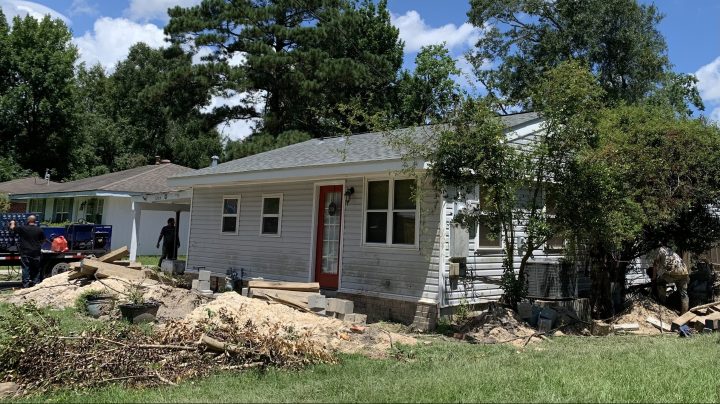
What does it take to lift a house? A lot of money, sweat and hydraulic jacks.
What does it take to lift a house? A lot of money, sweat and hydraulic jacks.

Update (Jan. 10, 2023): This story has been updated to include the amount FEMA has funded for elevating homes in Louisiana.
On a dead-end street in Slidell, Louisiana, near New Orleans, a little house is about to get a big lift — from ground level to more than 8 feet up.
Half a dozen workers, drenched in sweat from the July heat and covered in mud, have tunneled under the house and set up piles of wood blocks, or cribbing, along with 38 hydraulic jacks. The men crawled in and out, making small adjustments, while a supervisor eyed dozens of gauges.
“He’s adjusting all the pressures on each hydraulic cylinder individually,” explained Jason Soto. “That way when we lift the house, it guarantees it lifts at a constant rate.”
Soto is head of marketing at Davie Shoring, a company that specializes in elevating houses in the flood-prone Gulf Coast region. Lately, he said, it’s been busy.
“We have 18 [houses in progress] in the city of Slidell alone and probably about 25 in the surrounding areas as well,” Soto said.

Slidell is on Lake Pontchartrain and can flood when storms push water from the gulf into the lake and surrounding bayous.
“When the hurricanes come, we’re on the north side of the lake,” Soto said. “The winds push everything to us first, so we get a massive storm surge every single time.”
Demand for house lifting is growing, as the combination of sea-level rise and wetter storms brought by climate change increase flood risk in many parts of the country. In Louisiana, sinking ground, or subsidence, also plays a role. The Flood Industry Mitigation Association estimates 3 million to 4 million homes and buildings nationally, worth a collective $1.5 trillion, may need to be elevated.
The house in Slidell will be lifted in stages, about 8 inches at a time. After each lift, the workers “will build this crib pile up to where they can put the jack up higher, and then they will repeat the process,” Soto said.
While we waited for the first lift, the house’s owner pulled up in her car to watch the progress. Tracey Perry, a hairdresser, bought the house in 2006 for $97,500 after it had been damaged by Hurricane Katrina. Then, six years later, another severe hurricane hit the area.
“Isaac came in over the baseboards just long enough to get it nice and moist, and then it rolled out,” Perry said.

When the house goes up, she’s looking forward to her flood insurance going down. She pays about $2,000 a year for a 1,000-square-foot house.
“It’s tiny,” she said.
Lifting this tiny house will cost more than $100,000. A grant from the Federal Emergency Management Agency will cover 90%, leaving just over $10,000 out of pocket. But Perry expects the value of the house to grow, particularly as one of the only elevated houses on her street.
“Being on this dead end, I mean, hello,” Perry said. “She’ll shine like a star.”
According to a FEMA spokesperson, the agency has provided almost $329 million for home elevations in Louisiana in the years since Hurricane Katrina.
You might think the hoisting would be rough on a house, but not if it goes well. Perry took her pictures off the walls but left dishes and everything else pretty much as is. She planned to check in to a nearby hotel for a couple of nights.
“I’m actually looking forward to staying in the hotel,” she said. “They have a hot tub in a pool, so it’s like a mini vacation.”
The whole process — from applying for the grant to receiving it, then getting on Davie Shoring’s schedule — has taken about four years. And now, Perry would have to wait a bit longer. Soto came over with some bad news.
“So it’s going to be a little while,” he said.
When the crew started to lift the house, the addition on the back of the house had flexed, Soto said. “We have to do additional tunneling under the addition,” he said. “They’re going to put a couple more support jacks underneath the addition for the lift.”

In the end, Perry had to spend four nights away from the house, in two stages. But when we called her up recently, she was happy with the result.
“I love it. I just tell everybody in the neighborhood I’m the queen,” she said. “I’ll let them know if something’s coming. I’ll be able to see it first.”
She has discovered one downside of elevated living, though. In the fall she broke her ankle and had to negotiate the 18 steps to her door.
For more on how people and communities are adapting to sea-level rise, check out our podcast “How We Survive.”
There’s a lot happening in the world. Through it all, Marketplace is here for you.
You rely on Marketplace to break down the world’s events and tell you how it affects you in a fact-based, approachable way. We rely on your financial support to keep making that possible.
Your donation today powers the independent journalism that you rely on. For just $5/month, you can help sustain Marketplace so we can keep reporting on the things that matter to you.

















